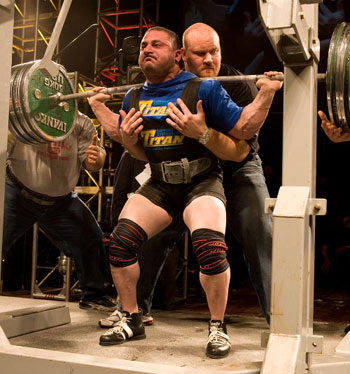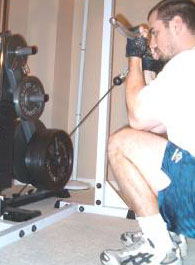|
Squatting Cable Curls
The biceps are the showpiece muscles of your physique. Well-developed biceps really stand out. To maximally develop the bicep muscles, you need to apply tension to them in three distinct areas of their range of motion (if you are familiar with Steve Holman's "Positions of Flexion" training, you'll recognize these areas). Most bicep exercises work only one area at a time. The Squatting Cable Curl exercise you are about to learn works all three at once!
 The first area is the stretch position. This position is worked in exercises that place the most tension on the muscle when it's stretched. This could be dumbell flyes for the chest or, for the biceps, incline curls. The body position of the incline curl (you lying on an incline bench with your arms hanging straight down) puts a stretch on the biceps muscle at the start of the movement.
The first area is the stretch position. This position is worked in exercises that place the most tension on the muscle when it's stretched. This could be dumbell flyes for the chest or, for the biceps, incline curls. The body position of the incline curl (you lying on an incline bench with your arms hanging straight down) puts a stretch on the biceps muscle at the start of the movement.
The second area is the mid-range. This is basically just the middle of the movement. Exercises that have most of their tension placed in the middle of the movement work the mid-range. For the biceps, this could be standing barbell or dumbell curls. You'll notice that they are hardest when you are halfway through the movement (90 degree bend in the elbows).
The third area is the contracted position. Exercises that have the majority of their tension when the muscle is contracted, such as concentration curls for the biceps, work this third area.
Taken separately, each of these three areas contributes to full development of the muscle. For example, if you wanted to do a bicep routine based on this theory, you could do one set of incline curls, two sets of barbell curls, then one set of concentration curls. This routine would ensure you are working all three tension-areas of the bicep.
But what if I told you there was an exercise you could do that would work all three of these areas at once? Each of the three movements I referred to above lose tension in the biceps at some point because of gravity and the positioning of the resistance. There is zero tension in the biceps at the bottom of the concentration curl. This factor decreases the effectiveness of the individual exercise.
The Squatting Cable Curl solves this tension-loss problem neatly and easily. First, I'll explain how to do it, then I'll tell you exactly how and why it works.
How To Do It:
To do this exercise, you will need a low pulley and a curl bar attachment (it can be the straight or cambered bar). There will be a link to pictures of the exercise at the end of the article.
Attach the bar to the low pulley and set a weight that is somewhat less than what you'd use for standing cable curls.
Squat all the way down (with your butt down on your heels) and grasp the bar with a regular curl grip. Rest the top sections of your forearms on the tops of your knees. Take a small step back so that the plates on the weight stack are raised up (you need to have tension at the bottom of the movement). You are going to be using your knees then your elbows as the pivot points for this exercise.
 When your arms are straight in this position, you should notice that your biceps are getting stretched. The weight is pulling foward and down while your knees are bracing your arms. This movement does require a bit of balance, especially when you are first getting used to it.
When your arms are straight in this position, you should notice that your biceps are getting stretched. The weight is pulling foward and down while your knees are bracing your arms. This movement does require a bit of balance, especially when you are first getting used to it.
Start the curling movement, rolling your forearms up and over your knees. This rolling pivot point changes the angle of tension on the biceps all the way through the movement.
As your forearms roll up and over the top of your knees, the pivot point will then move to your elbows. This will again change the angle of tension of the exercise.
Continue the movement, curling the bar up as close to your face as possible. Squeeze the biceps hard at the top. You should feel an extremely powerful contraction at this point as your biceps have had tension on them for the entire movement. To increase the feeling of the contraction, you can lean your body back somewhat (as though you are about to roll backwards).
Now reverse the sequence, rolling your forearms up and over your knees again. Get a stretch at the bottom (with your arms completely straight and the weight pulling on the biceps) then repeat.
How and Why It Works:
The Squatting Cable Curl works by using the cable and your body parts and positioning to apply variable tension to the biceps. It applies tension to the biceps during all three areas of the movement: stretch, mid-range and contracted positions.
At the very beginning of the movement, when your knees are pushing your elbows up and the weight is pulling your hands down, you are getting a strong biceps stretch. By applying tension to the biceps, i.e. curling the weight, you hit the stretch area.
As your forearms roll over your knees, the biomechanics of the movement change. You are now applying direct tension in the mid-range of the exercise. The best part is, because you are rolling your forearms over your knees, the angle of pull is constantly changing. This means you are getting direct tension on the many different angles of the mid-range area.
When you come to the point where your forearms roll completely off your knees and you begin pivoting from your elbows only, you are focusing on the contracted position. At this point, you can maximize the tension of the contraction by consciously squeezing the biceps hard and pulling the bar as close as you can to your face.
One of the bonuses of this exercise is the fact that your arms are braced against your legs throughout the movement. This effectively prevents any cheating due to body or arm movement. This bracing forces strict form, which makes the biceps do all the work in the exercise.
Conclusion:
The "evolving-tension" movement covers all three of the major areas of muscular tension at once. Your biceps get no break from the work at any point in the movement. This continuous tension during all angles and phases is an extremely effective way to build the biceps.

More Articles by Author Nick Nilsson
Return To Weight Lifting Articles Archive
|